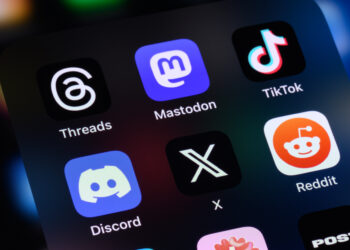This article was assembled by Stephanie Lovegrove Hansen (VP of Marketing at Silverchair), Susan Willner (Associate Director of Publications at the American Society of Nephrology), and Anne Stone (Stone Strategic Marketing Services), all members of the SSP Marketing & Communications Committee.
One year into Elon Musk’s acquisition of X (formerly known as Twitter), engagement metrics are down across the board, with app downloads down 38%, web traffic down 7% globally and down 11.6% in the U.S. “What is UP with Twitter?” “What about Threads?” “Is Academic Twitter disappearing?” “Could BlueSky be the replacement?” Are your metrics changing? These are questions we continue to hear in personal conversations, organizational meetings, industry articles, and in gatherings of the Society for Scholarly Publishing (SSP) MarComm committee. As we all reconsider our approaches and channels, we asked the community to weigh in with their response to the question, “How has your / your organization’s approach to social media changed in the last year?”
Plus: As the scholarly publishing community seeks to find each other on new platforms, we invite you to share how your use of social media is changing personally and professionally with our very simple 5 question survey. We’ll publish the results after the survey closes on December 1st.
Ryan Reeh, Senior Digital Publishing Strategist | American Academy of Pediatrics
In the HSS community and for some STEM publishers/organizations, there is some evidence for generational differences in the way authors, editors, and readers consume journal content; the newer platforms competing with Twitter/X have had various levels of response, but it’s not ‘the same’ as it was when Twitter was foregrounded. Some organizations are considering the reputational risk of being on Twitter/X while misinformation runs more rampant on the platform than they have before. At my organization AAP, our Public Affairs department is looking into changing the footer from the Twitter bird logo to the X logo. That kind of decision would be an easy call not that long ago, but not when our readers and editors routinely ask us why we continue to be on that platform at all.
Amye Kenall & Graham Smith, Altmetric
We still see a good amount of engagement with research across social media. For example, we still collect 100ks of X posts a week and X usage in general continues to track as above what we saw before the COVID pandemic spike. That said, social media is not what it was 10 years ago; nor are our technological capabilities. We plan to evolve with these changes. We are looking into how we can surface more insights from our existing social media platforms while expanding our coverage of emerging platforms. Importantly, we are always keeping a close eye on what would provide the most value to our users without infringing on their data rights. We will continue to engage and evolve with what fits their needs best.
Chhavi Chauhan, PhD, ELS, Director of Scientific Outreach, American Society for Investigative Pathology
I used to be a lot more active on social media, but with constantly shifting services and changing values, my engagement on various platforms has considerably decreased. I leverage LinkedIn most extensively, but with the emerging algorithms that diminish organic engagement and the recent layoffs (indicating deteriorating services and potentially inadequate platform maintenance), the involvement/dependency is now debatable. I have completely disconnected from social media channels like Facebook/Meta platforms (for the past three years) and Twitter/X (since early this year) as the policies of the leadership overseeing these social media platforms do not resonate with me, and their public stance and emerging changes were an indication of deteriorating service and values. I have always been slow at adopting new services so I continue not to engage on TikTok and such. I rely more on engaging with my network via blog posts and articles.
My organization (a not-for-profit society) has continued to maintain a presence on Facebook, LinkedIn, and Twitter/X, though we have had several issues with X no longer adequately supporting our content. It would be worthwhile for us to revisit the return on investment (ROI) on various platforms, in terms of resources and labor/effort, etc. on various platforms to define a strategy for 2024 as we have limited personnel bandwidth.
Roger Layton, Communications & PR Manager, BYU Library
In the last year we’ve experimented with TikTok, walked away from Twitter (no one noticed), and focused on Instagram because that’s where we still see engagement with our target audience. We’ve started a Threads account in part to see where it goes and in part to protect our institution name. Facebook still has value for specific groups, our Family History page has a loyal following, and we post job openings on librarian group pages. We use Facebook more like a bulletin board than what we used to think of as social media.
Christine Orr, Director of Sales and Community Outreach, BioOne
We employ social media not only to advance the mission and activities of BioOne as part of the scholarly communications field, but as a powerful tool to disseminate the biological and environmental research produced by our community of nonprofit and society publishers, especially beyond academia. But as in nature, change is constant. While X (formerly Twitter) has traditionally been an active platform for our disciplines, we are carefully monitoring how its recent changes are affecting the engagement with our publishers’ content. Thus far, we have not seen a clear alternative platform emerge, but we’ll be ready to migrate and augment our strategy in response.
Jennifer Regala, Director of Publications/Executive Editor, American Urological Association
I spend a lot of time on social media – but I do so with a mission and with passion. I have found social media as an important tool in my ongoing quest for community and engagement with my peers. I joined Twitter to grow my scholarly publishing network in 2018, and that’s where I met so many of you. Angela Cochran live tweeting from Berlin about Open Access in 2019 was pivotal for me. It was like I was in the room myself except in a smarter person’s mind. It was phenomenal. Then COVID – you all kept me connected to a world I cherish so much. But where are we all hanging out now? Many of you left Twitter, with good reason. I see some of you on Bluesky. A handful of you are on Threads. And most of you are on LinkedIn, but it’s harder to be “ourselves” on a professional career platform.
As for the American Urological Association, I am really fortunate to work with a very skilled social media team. We continue to rely heavily on Twitter to disseminate our journal articles and still see a lot of engagement there. Each of our journals also has an Instagram handle, and those accounts are growing in followers and engagement. Videos are extremely accessible and popular. We have one shared LinkedIn platform for all AUA messaging, which performs well. And we still stick around on Facebook for those who still lurk there. I am also super fortunate to have a team of online content editors who represent all of our publications. They are social media power users and understand our publications and the new offerings on the horizon. Our strategy works well, but I recognize the privilege of a really knowledgeable team of physician volunteers and extremely skilled AUA employees.
Kelly Henwood, Senior Manager & Rowan Baughan, Senior Marketing Executive, TBI Communications
In 2023, TBI has seen a 53% increase in our LinkedIn followers and average engagement rates across LinkedIn have been approximately 4% higher than on X. However, engagement on X is still well above average and continues to increase. We’ve joined Threads, BlueSky, and Mastodon to monitor activity and understand where our community is. We expect that if X introduces paid subscriptions, then the use of BlueSky will accelerate.
Negative perceptions surrounding X have led to a decline in brand loyalty. Many clients are eager to distance themselves from the blue tick on X but cannot when running paid campaigns, which remains a crucial channel for raising awareness. Organizations are under pressure to establish a presence on new platforms in preparation for potential audience migration. However, at this stage, with no clear alternative in sight and well-established communities on X, it’s often unrealistic for our clients to completely abandon the platform.
Laura Simis, Director of Marketing, Hum
Everything that has gone on with X this year has been a constant reminder not to put all your eggs in one content basket. We’ve dabbled in Bluesky, Mastodon, and Threads — and now is a great time to experiment with those channels! — but until the bulk of our audience moves on, we’re still prioritizing X and LinkedIn. Some of the big shakeups with the major tech players have opened some cracks in the walled gardens, and brands have an opportunity to find fresh ways to grow new audiences and foster conversations. We’re relying less on Facebook and LinkedIn ads as a way to get content in front of the right eyeballs, and investing that time and budget in other places.
Todd Carpenter, Executive Director, NISO
NISO has been active on social media in various forms since the late 2000s. Over the past year, there have been several developments that have led us to shift our approach. Because of the shift of leadership at Twitter and subsequent changes in how the algorithms rank and display posts, engagement and traffic has dropped significantly. In part, this led us to setup our own Mastodon server, create BlueSky accounts, and drive more engagement onto LinkedIn. We are monitoring the success of these moves, but with no clear community favorite emerging just yet, that presents some challenges for smaller orgs like ours.
Jacklyn Lord, Marketing and Operations Manager, Society for Scholarly Publishing
I’ve become much more hands-on in the last year. We tended to rely on Twitter, especially because it was integrated with so many platforms. As connections broke, I had to find solutions for each and this meant far more time managing our presence with more individual posting. A possible upside is that this organic activity could be rewarded by ‘the algorithms.’
We’ve seen growth in followers to our LinkedIn accounts since January, 27% for The Scholarly Kitchen (TSK) and 25% for SSP while followers on Twitter and Facebook have stayed pretty steady. LinkedIn has also doubled the impressions delivered for TSK, while staying stable for SSP. With this new interest from LinkedIn users, we should be sure people are aware of our Society for Scholarly Publishing Professionals Group, open to all with an interest in the scholarly communications and publishing community.
There are sometimes differences in content consumption by platform. LinkedIn audiences tend to create organic content and mention SSP and TSK’s accounts while X audiences tend to share our posts without comment. SSP is exploring emerging platforms like Threads, parking our username and observing what our community is doing, and we are considering leaving X for Bluesky (find us there @scholarlypub.bsky.social and @scholarlykitchen.bsky.social) and we have renewed focus on email and SEO to account for the tumult.
Perhaps the decline of Twitter/X as a monolith will mean the return of niche online communities like our C3 Forums. The new C4DISC DEIA Community of Practice and the Scholarly Publishing DEIA Resource Forum are open to everyone. On-demand Webinars are also consistently popular like the Innovation Showcase delivered with support from Cadmore Media.
Where are YOU engaging? How has that changed? Let us know in this brief survey, and stay tuned for the results!
Discussion
5 Thoughts on "Ask the Community: How are you using Social Media in 2023? "
The Researcher to Reader Conference (which I Chair) “went dark” on Twitter (now X) in November 2022, as even then it was, in my view, becoming unacceptably toxic and ‘personality-cult-driven’ under its new ownership. Additionally, the signal-to-noise ratio seems to have gone from something like 10:1 to 1:2 since then as irrelevant click-bait posts have been prioritised over any ‘followed’ networks. So now there are both moral and practical incentives to abandon this medium, even if still waiting for ‘a clear alternative platform [to] emerge’.
LinkedIn has now become the leading, but mildly unsatisfactory, alternative for us.
We have also established an online R2R Community Forum, as an alternative means for relatively informal community-wide communication. It is incredibly hard to create momentum in a forum of this kind, however, and we currently have almost zero traction (as expected), but we shall see if it ‘spins up’ during the Conference in February, and then can sustain that energy afterwards.
Mark, I’m sympathetic to the challenge of generating momentum in smaller communities on specific platforms. Until social media platforms began (LinkedIn 2003, Facebook 2006), the promise of the Internet for conversation seemed like wishful thinking of people who managed listservs in the ’80s and ’90s. It’s been chilling to see research on harms of social media to the Gen Z / late Millennials. Change remains the only constant. This week’s AP headline: A Meta engineer saw his own child face harassment on Instagram. Now, he’s testifying before Congress – https://apnews.com/article/social-media-teens-meta-instagram-arturo-bejar-5f7fb7d55fb9f0da12cf3a57837fa0c5
At EASE we have an open discussion Get Together scheduled in December to discuss this very topic, so it is a nice prescient coincidence to see two articles on these pages this week.
Interesting to read all these comments about social media experiences, and several articles that have posted not just here, but other places too recently. It does feel like social media habits have got a little unfocused, and possibly unconstructive – like Mark describes it in his comment above, the signal to noise ratio can be overwhelming – and the time has come to reassess a few things.
Some use is becoming a tautological battle with the platforms themselves. Facebook/Meta are giving Pages the option to use ‘broadcast channels’ to send their followers messages about important things they want all their followers to see – that is exactly how the Page should work in the first place, if Meta didn’t deliberately restrict reach. That is very much creating the problem then selling the solution. Those features are tiring to deal with.
For the accounts I have been managing – my own professional profiles, EASE, the journals I work with and my personal accounts across various platforms – it feels like no one is fully satisfied with where they are, especially compared to the effectiveness of old school Twitter (or as fun as MySpace).
That said, I have noticed quite an upsurge in Twitter responsiveness and activity over the past couple of months, so I am wondering what the future is like – but ultimately it still doesn’t ’feel’ good there, and despite the stats looking better, I haven’t actually spoken to anyone that is too enthused.
I have been getting great responses on LinkedIn for EASE and my journals, and personally my feed is not too polluted with LinkedInfluencers (and I find them far less toxic than the posts pushed in to Twitter feeds). There are a lot of very useful and effective tools in LinkedIn that have been working very well for me, and responses to posts and growth of pages have been great, so that is something of a focus for me if I was to pick one…..which I won’t (like Laura Simis says, not putting all my eggs in one basket).
at the risk of a tl;dr response, I’ll had over to the youth:
My daughter asks me why I am using these “old man apps” on my computer anyway, because if I’m not posting to TikTok with CapCut on my phone them I am irrelevant. So there’s that.
Thanks Duncan – let’s be in touch after the survey closes before your GetTogether so we can compare notes on the community response to the survey – please take and share here https://bit.ly/SSPSoMeSurvey
Social media never stays the same (never heard of CapCut). It is important to know what the objectives are and the audience one is trying to engage. Who uses which platform and for what purpose definitely shifts with generations and new offerings – and some older ones stick around – Reddit seems resurgent (anecdotally)…
Thanks Anne, it would be great to discuss before the Get Together.
I took the survey, and will share it around. The results could be quite helpful for many people interested in this article. I’ve had a few conversations with different journal managers and editors now,wondering where to go or whether to even put as much effort in to social media as before. Perhaps we are ready for a whole new format of communication.




